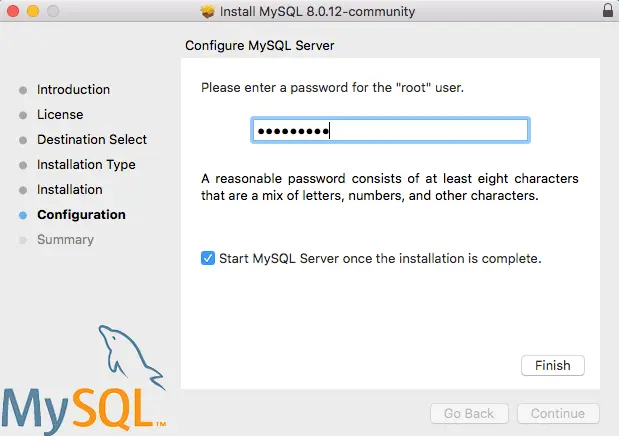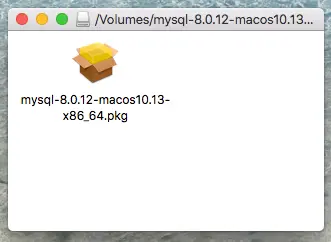To work properly, these programs must be added to your Mac OS X system path. To add the MySQL command prompt programs that come with MAMP to your Mac OS X system path, follow these instructions. So many ways to do it. From Workbench: File Run SQL Script - then follow prompts From Windows Command Line: Option 1: mysql -u usr -p mysql source filepath.sql Option 2: mysql -u usr -p '-e source filepath.sql' Option 3: mysql -u usr -p path.sql Option 4: put multiple 'source' statements inside of filepath.sql (I do this to drop and recreate schemas/databases which requires.
A practical and useful application that contains all the available MySQL products in one package and allows you to install them on your system with a single mouse click

- Download MySQL Installer - A practical and useful application that contains all the available MySQL products in one package and allows you to install them on your system with a single mouse click.
- On Windows, use the following procedure to reset the password for the MySQL 'root'@'localhost' account. To change the password for a root account with a different host name part, modify the instructions to use that host name.
MySQL Installer is a practical and reliable software solution worth having when you need to install multiple MySQL products effortlessly.
Choose the components you want to deploy
MySQL Installer includes various apps such as MySQL Server, MySQL Workbench, MySQL Connectors, MySQL Notifier, MySQL for Excel and MySQL for Visual Studio. Each of them includes samples, examples and documentations that help you to understand better how they work.
The application comes with an intuitive wizard that guides you through the installation and configuration processes of MySQL products. Simply select the apps you want to have installed on your machine, specify the installation path and keep your system up-to-date.
It provides you with five different setup types namely Developer Default, Server only, Client only, Full and Custom. Each of them differ because of the products they install. For instance, the Developer Default option allows you to install all products needed for MySQL development purposes, while the ‘Server only’ option enables you to install only the MySQL Server product.
Automatically checks your system for compatibility
Still, the ‘Custom’ option is the most effective that helps you to manually select the products you want to be installed on the system. The left panel displays all the available programs that will be installed, while the right panel allows you to select only the components you are interested in. Macos iso. This way, if you expand all the available MySQL connectors, you can choose only the ones you want such as Connector/ODBC, Connector/C++ or Connector/NET.
Irrespective of which option you choose to use, MySQL Installer checks your entire system and generates a report that displays all the needed requirements before the selected products can be installed.
Macos Mysql Path

After you install all the additional programs required by the application, it will display all the products that will be installed or updated, depending on the option you chose in the first step.
A few last words
To sum things up, MySQL Installer is an effective solution especially designed for developers and database administrators who need to install multiple MySQL products with a single mouse click.
Filed under
MySQL Installer was reviewed by Cristina Jitaru
MySQL Installer 8.0.23.0
add to watchlistsend us an update- runs on:
- Windows 10 32/64 bit
Windows Server 2012
Windows 2008 R2
Windows 2008 32/64 bit
Windows 2003
Windows 8 32/64 bit
Windows 7 32/64 bit
Windows Vista 32/64 bit
Windows XP 32/64 bit - file size:
- 422 MB
- main category:
- Internet
- developer:
- visit homepage
top alternatives FREE
top alternatives PAID
If you have never assigned a root password for MySQL, the server does not require a password at all for connecting as root. However, this is insecure. For instructions on assigning a password, see Section 2.10.4, “Securing the Initial MySQL Account”.
If you know the root password and want to change it, see Section 13.7.1.1, “ALTER USER Statement”, and Section 13.7.1.10, “SET PASSWORD Statement”.
If you assigned a root password previously but have forgotten it, you can assign a new password. The following sections provide instructions for Windows and Unix and Unix-like systems, as well as generic instructions that apply to any system.
B.3.3.2.1 Resetting the Root Password: Windows Systems
On Windows, use the following procedure to reset the password for the MySQL 'root'@'localhost' account. To change the password for a root account with a different host name part, modify the instructions to use that host name.
Log on to your system as Administrator.
Stop the MySQL server if it is running. For a server that is running as a Windows service, go to the Services manager: From the Start menu, select Control Panel, then Administrative Tools, then Services. Find the MySQL service in the list and stop it.
If your server is not running as a service, you may need to use the Task Manager to force it to stop.
Create a text file containing the password-assignment statement on a single line. Replace the password with the password that you want to use.
Save the file. This example assumes that you name the file
C:mysql-init.txt.Open a console window to get to the command prompt: From the Start menu, select Run, then enter cmd as the command to be run.
Start the MySQL server with the
init_filesystem variable set to name the file (notice that the backslash in the option value is doubled):If you installed MySQL to a different location, adjust the cd command accordingly.
The server executes the contents of the file named by the
init_filesystem variable at startup, changing the'root'@'localhost'account password.To have server output to appear in the console window rather than in a log file, add the
--consoleoption to the mysqld command.If you installed MySQL using the MySQL Installation Wizard, you may need to specify a
--defaults-fileoption. For example:Testing conducted by Apple in October 2019 using preproduction 2.3GHz 8-core Intel Core i9-based 16-inch MacBook Pro systems with 16GB of RAM and 1TB SSD. The wireless web test measures battery life by wirelessly browsing 25 popular websites with display brightness set to 12 clicks from bottom or 75%.
 Apple’s M1 MacBook Air has that Apple Silicon magic The change came in Visual Studio Code 1.54 (now 1.54.1, thanks to a bug fix update), which is available as a universal 64-bit binary, as is. When closed, at its thinnest point it's 0.41 cm thick, compared with 1.49cm (0.59 inches) for the 13-inch MacBook Pro and 1.62 cm (0.64 inches) for the 16-inch MacBook Pro. 64-bit computing is replacing 32-bit, mainly because 64-bit enables faster hardware and software. Here's the rundown on the ongoing 32-bit vs.
Apple’s M1 MacBook Air has that Apple Silicon magic The change came in Visual Studio Code 1.54 (now 1.54.1, thanks to a bug fix update), which is available as a universal 64-bit binary, as is. When closed, at its thinnest point it's 0.41 cm thick, compared with 1.49cm (0.59 inches) for the 13-inch MacBook Pro and 1.62 cm (0.64 inches) for the 16-inch MacBook Pro. 64-bit computing is replacing 32-bit, mainly because 64-bit enables faster hardware and software. Here's the rundown on the ongoing 32-bit vs.The appropriate
--defaults-filesetting can be found using the Services Manager: From the Start menu, select Control Panel, then Administrative Tools, then Services. Find the MySQL service in the list, right-click it, and choose thePropertiesoption. ThePath to executablefield contains the--defaults-filesetting.After the server has started successfully, delete
C:mysql-init.txt.

You should now be able to connect to the MySQL server as root using the new password. Stop the MySQL server and restart it normally. If you run the server as a service, start it from the Windows Services window. If you start the server manually, use whatever command you normally use.
B.3.3.2.2 Resetting the Root Password: Unix and Unix-Like Systems
On Unix, use the following procedure to reset the password for the MySQL 'root'@'localhost' account. To change the password for a root account with a different host name part, modify the instructions to use that host name.
The instructions assume that you start the MySQL server from the Unix login account that you normally use for running it. For example, if you run the server using the mysql login account, you should log in as mysql before using the instructions. Alternatively, you can log in as root, but in this case you must start mysqld with the --user=mysql option. If you start the server as root without using --user=mysql, the server may create root-owned files in the data directory, such as log files, and these may cause permission-related problems for future server startups. If that happens, you must either change the ownership of the files to mysql or remove them.
Xampp Mysql Path Mac
Log on to your system as the Unix user that the MySQL server runs as (for example,
mysql).Stop the MySQL server if it is running. Locate the
.pidfile that contains the server's process ID. The exact location and name of this file depend on your distribution, host name, and configuration. Common locations are/var/lib/mysql/,/var/run/mysqld/, and/usr/local/mysql/data/. Generally, the file name has an extension of.pidand begins with eithermysqldor your system's host name.Stop the MySQL server by sending a normal
kill(notkill -9) to the mysqld process. Use the actual path name of the.pidfile in the following command:Use backticks (not forward quotation marks) with the
catcommand. These cause the output ofcatto be substituted into thekillcommand.Create a text file containing the password-assignment statement on a single line. Replace the password with the password that you want to use.
Save the file. This example assumes that you name the file
/home/me/mysql-init. The file contains the password, so do not save it where it can be read by other users. If you are not logged in asmysql(the user the server runs as), make sure that the file has permissions that permitmysqlto read it.Start the MySQL server with the
init_filesystem variable set to name the file:The server executes the contents of the file named by the
init_filesystem variable at startup, changing the'root'@'localhost'account password.Other options may be necessary as well, depending on how you normally start your server. For example,
--defaults-filemay be needed before theinit_fileargument.After the server has started successfully, delete
/home/me/mysql-init.
You should now be able to connect to the MySQL server as root using the new password. Stop the server and restart it normally.

B.3.3.2.3 Resetting the Root Password: Generic Instructions
Mysql Export Path Mac
The preceding sections provide password-resetting instructions specifically for Windows and Unix and Unix-like systems. Alternatively, on any platform, you can reset the password using the mysql client (but this approach is less secure):
Stop the MySQL server if necessary, then restart it with the
--skip-grant-tablesoption. This enables anyone to connect without a password and with all privileges, and disables account-management statements such asALTER USERandSET PASSWORD. Because this is insecure, if the server is started with the--skip-grant-tablesoption, it also disables remote connections by enablingskip_networking.Connect to the MySQL server using the mysql client; no password is necessary because the server was started with
--skip-grant-tables:In the
mysqlclient, tell the server to reload the grant tables so that account-management statements work:Then change the
'root'@'localhost'account password. Replace the password with the password that you want to use. To change the password for arootaccount with a different host name part, modify the instructions to use that host name.
Mysql Path Mac
You should now be able to connect to the MySQL server as root using the new password. Stop the server and restart it normally (without the --skip-grant-tables option and without enabling the skip_networking system variable).
